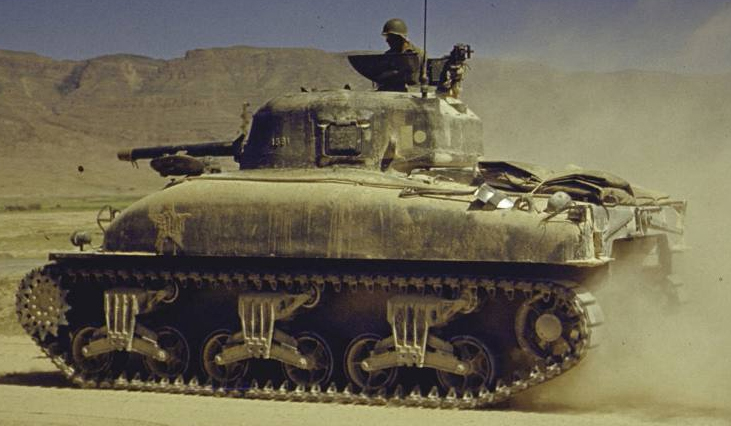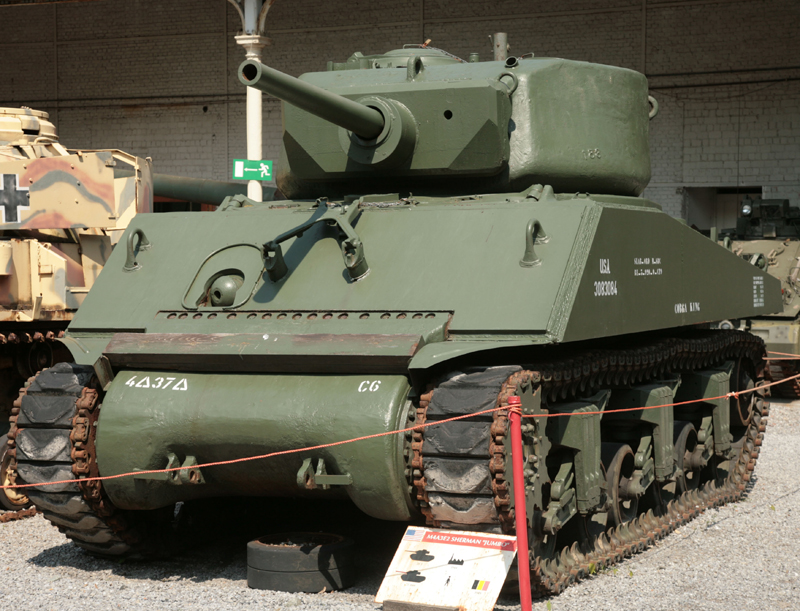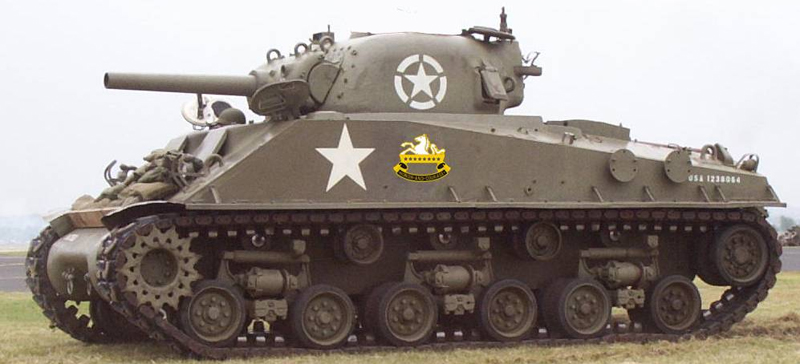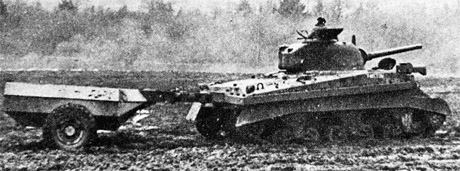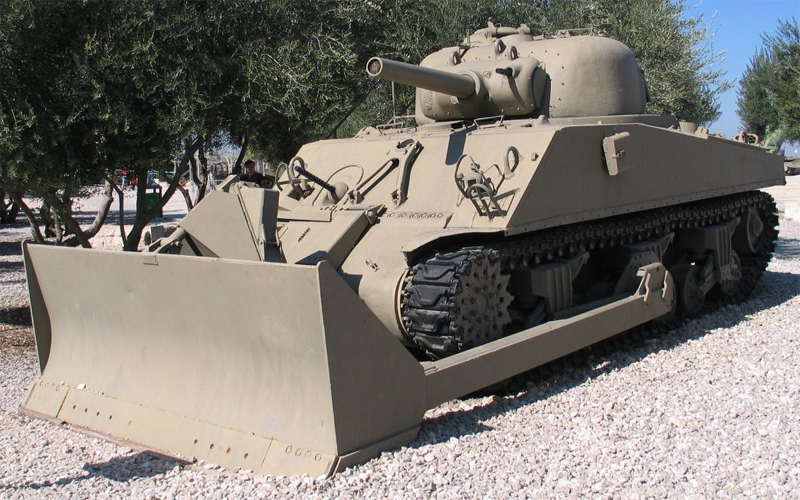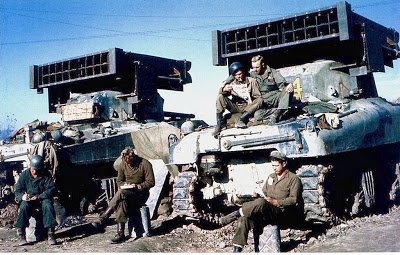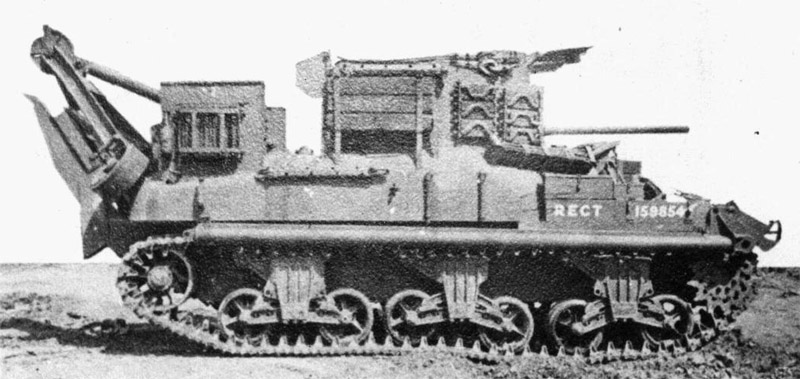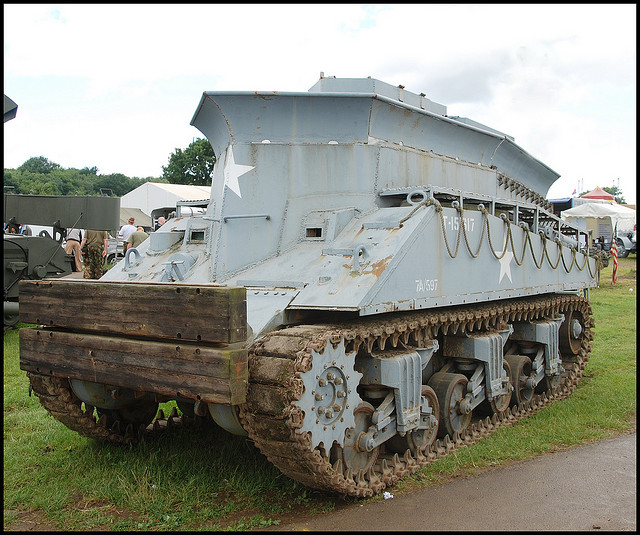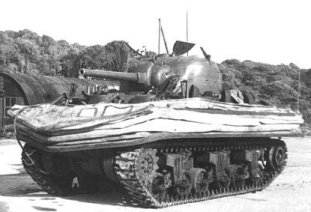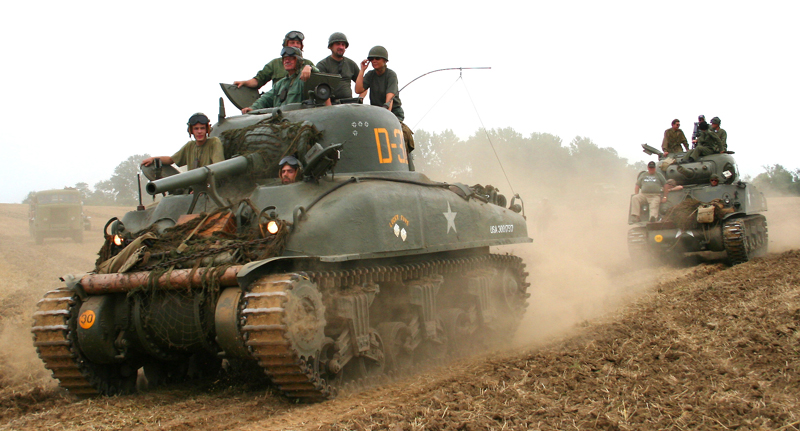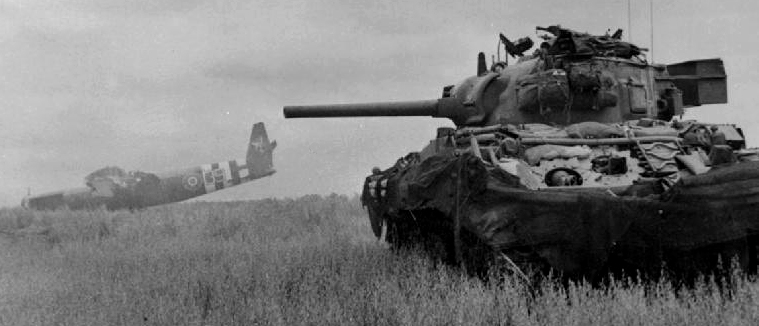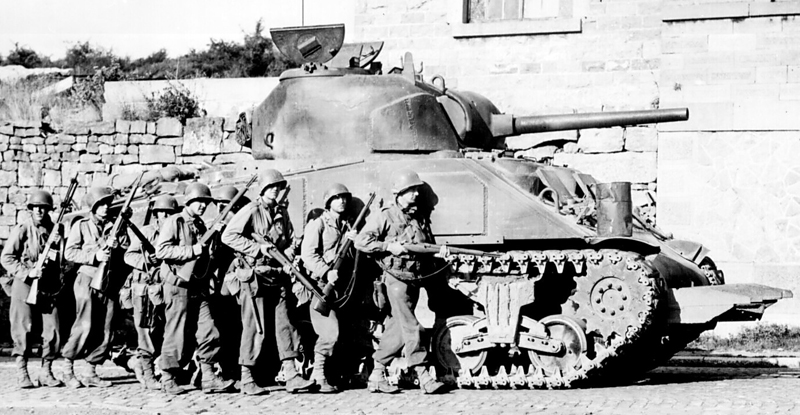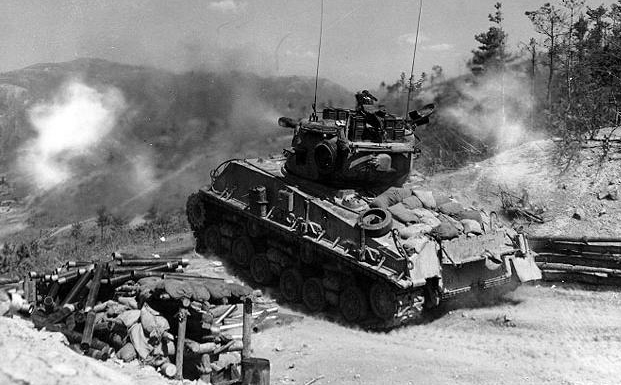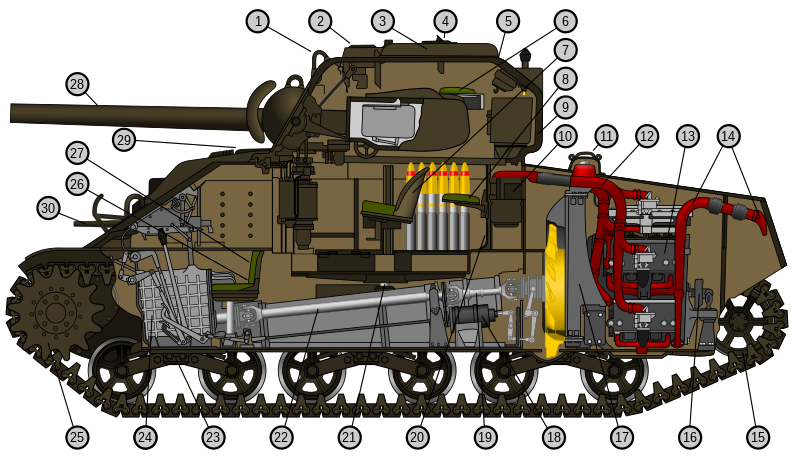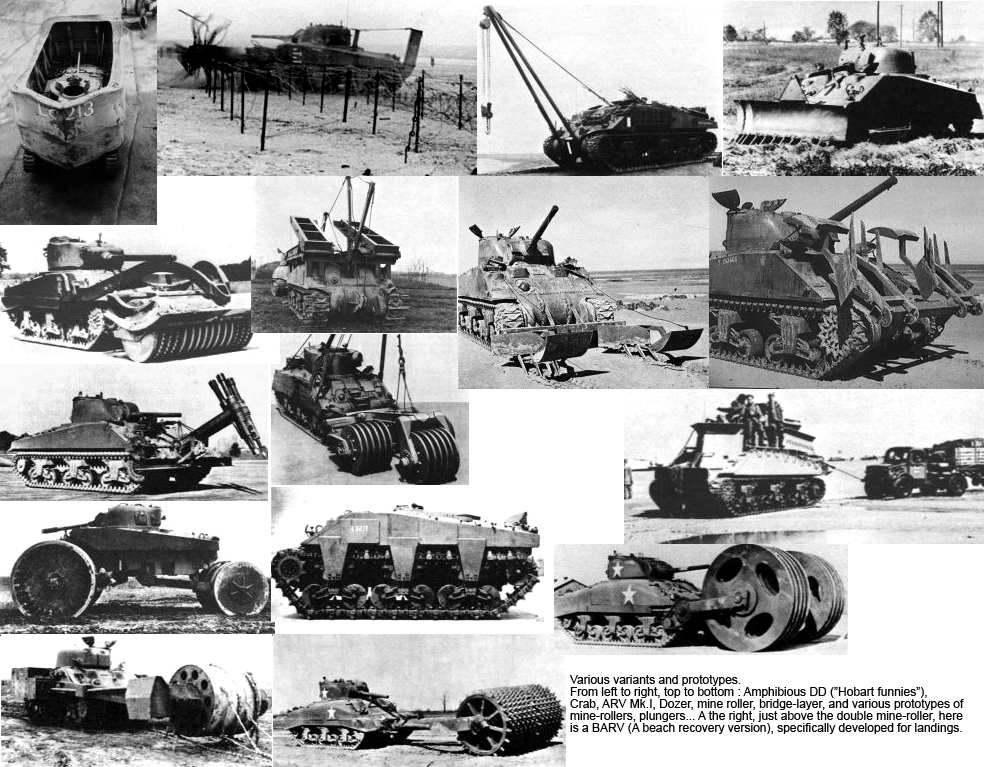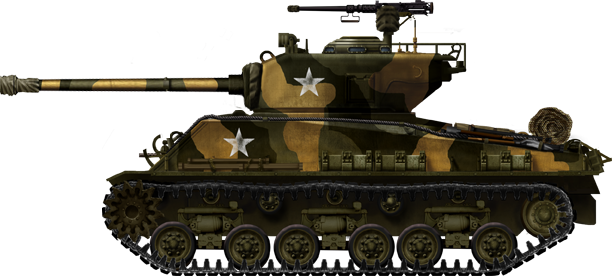Foreword: A winner by numbers
The M4 Sherman (named after the famous American Civil War general William T. Sherman) is one of the few really iconic fighting equipment of the Allies during Word War Two, and one of the most famous tanks in history. But this historic status was gained not thanks to its intrinsic qualities, but more to the sheer numbers in which they were provided, only surpassed by the Soviet Union’s T-34, with a staggering 50,000+ total delivered. It remains by far the most widely used tank on the Allied side during the war, it was derived into countless derivatives, and had a very long postwar career which lasted well into the Cold War. It has been largely compared to the T-34, and had the occasion to confront some during the Korean War.
However, the Sherman was not as successful as it seemed. Derived in a haste from the previous and controversial M3 Lee/Grant, it was the first to bear a fully-traversing turret with a 75 mm (2.95 in) gun. It was designed from the very beginning for mass-production. Cheap and relatively simple to build, easy to maintain, reliable, roomy, sturdy, fast, well-armored and well-armed, it was the good-all-around armored vehicle the Allies had sought for until 1942, when it first arrived on the North African front. It literally soldiered in every corner of the globe, under many colors, from 1942 to the end of the war. These theaters included (in WWII alone) most of North Africa, Russia, most of Europe, the Eastern Indies, China, the Philippines, many Pacific islands and China.
Genesis and context until 1940
By 1940, Great Britain had found itself desperately short on tanks. Some were provided through the freshly signed Lend-Lease agreement. At the same time, the US Army, fully learning from the shock caused by the Blitzkrieg in Western Europe, was in the process of emergency modernization of its equipment. The M4 was, in fact, the type of medium tank the US industry was not yet prepared to built in early 1940, which led to the intermediate M3 Lee. The latter was to be equipped with a fully revolving turret at first, but the urge in production imposed the choice of a transitional, yet unsatisfactory solution, a 75 mm (2.95 in) gun in a hull sponson. So, by late August 1940, as the M3 production started, U.S. Army Ordnance Department tried many solutions for mating a fully traversing turret with the M3 hull, which eventually led to the M4.
On April, 18, 1941, U.S. Armored Forces Board chose the T6, among five designs, to be the blueprint of a pre-production series. The final mock-up was approved in May and the definitive prototype sent to the Aberdeen Proving Grounds for extensive trials in September 1941. Basically, it was a M3 armed with the same main gun relocated in a large, rounded revolving turret. By the standards of 1940, the M4 offered a dependable gun platform able to deal with the main German tanks of the time, the Panzer III and IV, support infantry and make a breakthrough through speed and firepower. Its design was eased by the borrowing of many parts and innovations from previous models, the M2 light and medium tanks and the M3, like the efficient and well-proven vertical volute spring suspension, the rubberized track links, but, perhaps above all, a highly standardized, compact, light and powerful aviation radial engine, the Continental R975. This model was already largely produced for the aircraft industry, which assured comfortable provision of spare parts and ease of maintenance by any trained personnel. The engine was later the source of many criticisms about the M4, that the Allied crews learned the hard way, and which earned it, from both camps, some infamous nicknames.
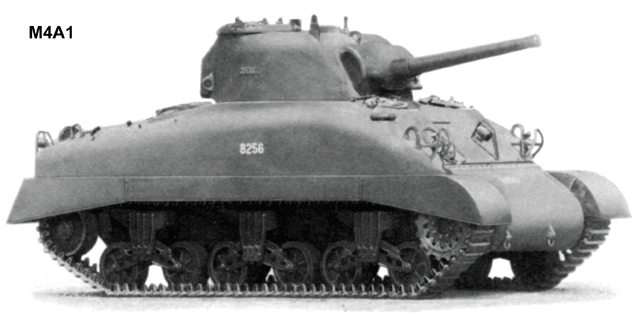
Design of the M4 Sherman
Designed from the drawing board to be produced as quickly as possible on the very same factory lines which were already delivering hundreds of M3s monthly, the M4 was kept as close as possible to its predecessor, including suspension, tracks, transmission, although with an entirely brand-new upper hull. Some details of the T6 disappeared on the standard M4 launched in October, like the side hatches (inherited from the M3), cast hull and the two additional hull machine-gun ports. Ease of production later dictated even more sacrifices and simplifications in the design. Just like the M3 Lee, the Sherman’s suspension was of the VVSS (Vertical Volute Spring Suspension) type. The running gear comprised three sets of bogies, each with two paired large rubber-covered roadwheels, a rear adjustable track idler wheel and front drive sprocket connected to the gearbox, and three return rollers. The 78-links track was of the standard model, although reinforced and modified to minimize ground pressure, first used on the M1 Combat Car back in 1937.
The Continental R975 engine, which was kept for nearly all versions, was an air-cooled, gasoline radial engine delivering 400 hp (298 kW) at 2400 rpm. It was fed by two tanks totaling 660 l (175 gal) of gasoline, which gave around 195 km of practical range (about 120 miles). Power-to-weight ratio was 15.8 hp/ton (11.78 kW/ton). The gearbox was spicer, manual, synchromesh, with 5 forward gears (plus overdrive), one reverse. The controlled differential comprised a built-in brake steering system, which was controlled through levers. There was also a parking brake. The engine compartment contained two fixed large fire extinguishers, manned by a crewmember from the fighting compartment. An auxiliary generator provided extra power and helped warm the engine during cold winters.
The lower hull was made of large welded parts, although the bogies were bolted to the hull for easier replacement or repair, and the rounded front was made of three bolted steel plates. Other external parts were either bolted or welded. The upper hull, at first cast, was later welded, with a well-sloped glacis, flat sides and slightly sloped engine compartment roof, making a characteristic tumblehome culminating just above the main turret. The back plating included a rear “U” shaped exhaust muffler, distinctive of the early production. The armor was 76 mm (2.99 in) thick on the nose and upper glacis, 50 mm (1.96 in) on the turret and upper sides and 30 mm (1.18 in) elsewhere. The upper hull, at first welded, was cast and rounded on the M4A1.
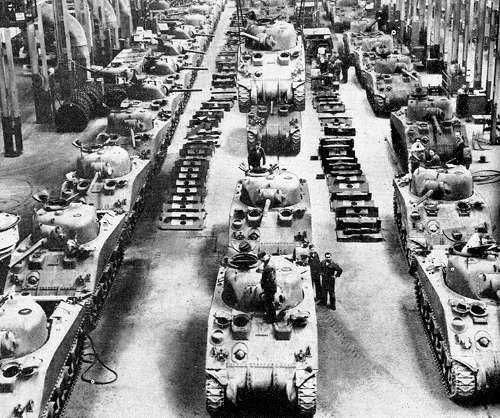
The driver sat on the left of the front of the hull, while the driver assistant sat on the right, firing a ballmounted cal.30 (7.62 mm) machine-gun. The main turret was roomy, enough for the three other crew members. The loader sat on the left of the main gun and the gunner on the right, while the commander was at the rear, just behind the loader. The three seats had adjustable mountings and could move 30.4 cm (12 in) up and down and 12.6 cm (5 in) forward and backward. The crew had two portable fire extinguishers, a 2-way radio and the use of an interphone. Access and evacuation could be performed through four hatches. Two above the frontal glacis, one revolving on top of the turret and one on the floor, just behind the driver’s seat. Peripheral vision was excellent thanks to five pericopes (one for each crew member), with a 360 degree traverse and vertical tilting. The turret, cast in one piece, comprised a large “basket” which helped turn the entire fighting compartment with it, revolving on a rail thanks to a Bendix electric system.
On early models direct vision slits, protected by thick bulletproof glass and hinged covers, were provided to the driver and assistant, but later eliminated due to wartime experience of bullet splashes. The gunner periscope contained a telescopic sight directly synchronized with the main gun, while the gun itself received a gyrostabilization hydraulic system for more accurate firing while on the move. The gunner aimed the gun with a hand wheel and fired through electronic impulse from foot operated switches. The main gun was a 75 mm (2.95 in) M3 L/40 model, provided with 90 rounds, at first protected by a Combination Gun Mount M34 and coupled with a fixed secondary cal.30 (7.62 mm) Browning M1919A4 machine gun. Both machine-guns (coaxial and hull) received a total of 4750 rounds in cartridge bands, with some tracers. Later models received the new M34A full mantlet, which also protected the machine-gun port. Anti-air and anti-personal defense was provided by the turret roof cal.50 (12.7 mm) Browning heavy machine gun, provided with 400 rounds. The main gun had elevation and azimuth control and FM radio liaison with an artillery center for stationary gunnery support. The M4 was rugged and could endure a 2500 miles run before requiring any form of maintenance. This was particularly appreciated in many emergency situations, notably Patton’s famous “wild rides”, reminiscent of the Blitzkrieg throughout Europe.
Production of the M4
The first factory which delivered the M4 was the Lima Locomotive Works. All of these first batches were sent to the British Army through Lend-Lease, and fought in Africa. They found themselves instrumental in many operations which turned the tide of the war in this sector in favor of the Allies. At first, production rate was of 1000 M4s a month, but rose quickly as more factories were involved (11 total), to a figure of 2000 each month by mid-1942. These included (for all variants) Pressed Steel Cars Co., Pacific Car & Foundry, Baldwin Locomotive Works, American Locomotive Co., Pullman Car, Chrysler’s Detroit Tank Arsenal, Pullman Standard Car Manufacturing Co., Federal Welder, Fisher and Grand Blanc in Michigan, the last being specially built for the purpose during the war. A total of 6748 M4s (from July 1942 to January 1944) were produced, as well as 1641 of the late variant equipped with a 105 mm (4.13 in) howitzer for infantry support, the M4(105). Early models had the three-piece bolted nose, while later models had a mixed cast/rolled hull. The gun mantlet also evolved from the M34 to the more protective M34A.
The M4A1 (British Sherman Mk.II)
This first major version was introduced early on in February 1942. It had a fully cast, rounded upper hull. Production of the regular M4A1 totaled 6281 machines until December 1943, but it was replaced by the M4A1(76)W, which received a more recent 76 mm (2.99 in) M1 main gun. 3396 of these improved models were built until March 1945. Performance of the regular “short” M2 75 mm (2.95 in) L/31 varied with the ammunition used, to a range from 259 m/s (850 ft/s) (smoke round) to 587 m/s (1926 ft/s) (APC M61), while the longer M3 L/40 allowed a 731 m/s (2400 ft/s) muzzle velocity. But the most efficient was the 1943 model 76 mm (2.99 in) M1 & M1A1 L/55, which had a 792 to 1036 m/s (2600 to 3400 ft/s) muzzle velocity with the HVAP ammo, being capable of piercing an 100 mm (3.94 in) steel plate at 450 m (1476 ft). Maximum range was 14 km (8.69 mi). Following a painful war experience, the ammo racks and fuel tanks were protected by watery jackets. The commander cupola was also new, featuring 6 prismatic vision blocks 76 mm (3 inches) thick with laminated bullet-proof glass. The engine was the modernized Continental R975-C1.
The M4A2 (British Sherman Mk.III)
M4A2 and M4A2(75)W
This evolution came in April 1942, with a new General Motors 6046 engine (two GM 6-71 General Motors Diesel engines), welded hull with extra applique armor on the hull sides and gunner position (left side of the turret). It was produced to a total of 8053 until May 1944. Early versions of the M4A2(75), had small hatches and protruding drivers’ and co-drivers’ hoods, a 57 degree glacis and dry ammo stowage bins. The rear hull plate was sloped. A transitional version built by Fisher, the M4A2(75)D, had a one-piece 47 degree glacis, with large hatches, but it still used dry ammo bins and applique armor. This model was also produced with a diesel GM 6046, 410 hp, used mostly by the British and the USMC. Range was 241 km (150 mi) with 641 liters (170 gal) of fuel (consumption was 279 liters/100 km or 118.6 gal/mi), total weight 31.8 tons, with a 1.01 kg/cm³ ground pressure. The hull frontal glacis was 108 mm (4.25 in) thick.
M4A2(76)W
The M4A2(76)W was the upgunned late variant, of which over 3230 will be delivered until May 1945. It was fitted with the modified T23 turret, which housed the M1 L/55 gun, which gave an overall length of 7.57 m (25 feet). With the GM 6046 diesel, and 673 liters (178 gal) of fuel, range was 161 km (100 mi). The weight rose to 33.3 tons. The glacis was at 47 degrees, 108 mm (4.25 in) thick with large hatches. By early 1945, the HVSS suspension was fitted.
The M4A3 (British Sherman Mk.IV)
M4A3
The M4A3 was first delivered by the Ford Motor Company in June 1942, alone delivering 1690 machines by September 1943. It was produced to a total of 5015 by all manufacturers combined. Early versions still had the dry ammunition stowage, direct vision slots for the driver and the 60 degree hull glacis (89 mm/3.5 in). The 3071 next had wet ammo stowage and a newer commander cupola. Most of all, it featured the new liquid-cooled Ford V8 500 hp engine, which was capable of giving a top speed of 42 km/h on road (26 mph), and a 209 km (130 mi) range. The suspension was the unchanged VVSS, but the transmission was now protected by a one-piece cast steel armored cover. Driver vision slots were augmented by bullet-proof glass and protective covers. Mid-production they also saw the adoption of duckbills, extended end connectors for the tracks, which improved the grip on soft terrains. Early series also saw extra 25 mm (1 in) thick applique armor welded over the ammo storage bins and the turret gunner position, later removed. By 1943-44, the recognition white stars were usually painted black or olive drab in order to mask them to enemy gunners, which used them as an aiming point.
M4A3(75)W
The M4A3(75)W was equipped with the longer barrel M3 L/40 gun, and over 3000 will be delivered until March 1945. Modification range was similar to the M4A2(75)W. At first it had the early hull type, with “dry” stowage and a 60° glacis plate, later gaining “wet” stowage with a 47° glacis, 108 mm (4.25 in) thick.
M4A3(76)W
The 76 mm (3 in) version, the M4A3(76)W was first introduced in March 1944 and a total of 4500 were delivered until April 1945. Modifications range was similar to the M4A2(76)W.
M4A3E2 “Jumbo”
The Allies quickly realized they needed a “breakthrough tank” for the upcoming Normandy campaign. A total of 254 Sherman M4A3s were hastily modified between June-July 1944, equipped either with 75 or 76 mm (2.95-3 in) gun, welded hull and gasoline Ford GAA V8 with a 764 liters fuel tank (261 km range), and the thickest frontal armor so far, with applique armor on the frontal glacis of 89 mm (3.5 in), which gave a total of 178 mm (7 in)(doubling the original thickness). Total weight was 38.1 tons. The “Jumbo” was able to resist all German AT guns including the 88 mm (3.46 in), and even the Tiger was unable to penetrate them frontally. The bad side of this upgrade was high fuel consumption and poor maneuverability. However, their success in operations led to a dramatic increase in the “Easy Eight” series production, already available in small numbers in April-May 1944 on the British side.
M4A3E8 “Easy Eight”
A famous derivative, the M4A3E8 or “Easy Eight”, first produced by Detroit Arsenal factory, had a 47 degree sloped glacis with large hatches, wet ammo bins, full up-armored sides, new HVSS suspensions, a revised turret with the long 76.2 mm (3 in) gun fitted with a muzzle brake. They were designed on British specs (local denomination “Sherman AY”), and were produced from March 1944 to April 1945, with 4542 units total. Many had upper side skirt protection. They were fast, with the Ford V8 500 hp, giving 47 km/h (29.2 mph) , gasoline, giving a range of 161 km (100 mi), for a 475 l/100 km (201.94 gal/mi) consumption. The glacis armor was upgraded to the “Jumbo” standard, with 178 mm (7 in). These saw action in the latest phases of the conflict in Europe and in the Pacific. The “Easy Eight” was retained in service long after the war and saw service in Korea and Vietnam, as well as in many foreign armies. The Israeli modified this model to such an extent (M50/51 “Super Sherman”) that it was in active service until the late 80s.
The M4A4 (British Sherman Mk.V)
This series was first introduced in July 1942 and produced until November 1943, to a total of 7499 machines. It had the most resistant welded hull of all the series, despite a downgraded armor (76 mm (3 in) glacis), and received a new composite Chrysler multibank engine (made of five car engines) which needed more space (the hull was lengthened by 15 cm/5.9 in) and scrupulous, careful maintenance. This model was not particularly appreciated with US crews and most went to the British and other Allied forces. The Russians were the most prolific “customers” of this version, but they didn’t like it either, because of the sensitive engine and relatively light armor. The British, Canadian, Australians, Free Polish and Free French all fought in Italy with this model. They also saw service at El Alamein, during the Tunisian campaign, Sicily and Western Europe. But by mid-44 up-armored and up-gunned models gradually replaced them. Losses had been heavy, not only because of enemy fire. The engine rarely caught fire when hit, but caused trouble because of complicated maintenance issues and long or delayed repairs.
The howitzer version: M4(105)
M4(105)
First introduced in February 1944, production stopped in March 1945, after a total of 1641 machines. It was devised during the Italy campaign, to give added infantry support firepower with the advantage of a fully traversing turret. In fact, the M7 Priest was one of the most widely used SPGs during this particular campaign. The standard M1919A4 howitzer was modified and compacted for the task. All existing gun aiming and facilities for indirect fire were improved. Armor was slightly thinner than usual, ranging from 63 mm (2.48 in) (glacis sloped at 47 degree), 38 mm (1.5 in) for the sides and rear and 19 mm (0.75 in) for the top. The mantlet was 91 mm (3.58 in) thick, turret front was 76 mm (3 in), slopes were 51 mm (2 in) and top 25 mm (0.98 in). The engine was the early radial Continental R975-C4, 9-cylinder 4-cycle, air cooled (15,945 cc and 460 hp at 2,400 rpm), giving a range of 161 km (100 mi) and a cruise speed of 38.6 km/h (24 mph) on road.
M4A3(105)
Produced from May 1944 to March 1945 with a total of 3039 machines. It had every improvement of the regular A3 series, and thus was more successful. It appeared quickly that the punch of a solid HE round was also more than adequate in many tank to tank engagements against German armor. Used in conjunction with “Zippo” (flamethrower) versions, the USMC deployed these support pairs with high profit against Japanese fortifications.
The M4A6, for the USMC
This model had a cast front with welded and lengthened sides and was propelled by a diesel Caterpillar D200A radial. A total of only 75 were delivered between October 1943 and February 1944 by Detroit Arsenal. Nearly all saw service only with the USMC in the Pacific, where diesel tanks were preferred for service, as a compatibility issue with other materials used.
A famous offspring: The Sherman Firefly
The Sherman Firefly was in fact a British project, which started as soon as the highly successful British AT QF 17-pdr (76.2 mm/3 in) was chosen to equip the new generation of Cruiser tanks. Paradoxically, it had been rejected in 1943 by the Ministry of Supply’s Tank Decision Board, on the charges that the already planned Centurion and Comet would be sufficient. At the same time the Cromwell, fitted with a Vickers 75 mm (2.95 in) and the Challenger, with the 17-pdr (76.2 mm/3 in), just entered intensive tests before production.
The Firefly was the brainchild of veteran tank commander Lt. Col. George Witheridge and Major George Brighty, working at Lulworth on the A30 Challenger project. They militated for the project despite official opposition and the final prototype was given roots thanks to the work of W.G.K. Kilbourn, an engineer from Vickers, which succeeded in adapting the turret to its new purpose. As the A30 project suffered further delays, after the final tests in February 1944, a 2100 order for the modified Sherman was given the highest priority by Winston Churchill himself. The “Firefly”, also officially called Sherman VC or IC, was produced until the end of the war in Europe, in May 1945, from Lend-Lease shipped hulls and turrets, based on M4A4, M4 and composite hulls. 500 were ready and took part in the Normandy campaign, and many more were produced until the fall of Germany. Exact numbers are still elusive. Jane’s WWII vehicles records stated a total of 2346 Fireflies.
Derivatives of the Sherman
M10 Wolverine Tank Destroyer
Officially called the 3-inch (76.2 mm) Gun Motor Carriage M10, first introduced in late 1942. Over 6700 were built. The regular version used the Medium Tank M4A2 basis and the M10A1 used the M4A3.
M36 Jackson Tank Destroyer
Ordinance 90 mm (3.54 in) Gun Motor Carriage M36, development of which lasted from March 1943 to June 1944, began to appear in Europe in September 1944. 1400 were built and they had a long postwar career.
M7 Priest HMC
Derivative using the standard M1/M2 105 mm (4.13 in) howitzer. First introduced by April 1942, 4443 were built until the end of the war. This number includes the sub-variant M7B1, the British personnel carriers M7 “Defrocked Priest” and Canadian Kangaroo.
Ram and derivatives
A famous Canadian-built version (around 2000 built between 1942-44), kept for training only, featuring many differences from the Sherman.
Sexton: A HMC carrying the Ordnance QF 25 pounder (87.6 mm/3.45 in), which replaced the Bishop. Around 2000 built by the same manufacturer as the Ram, Montreal Locomotive Works.
Grizzly Mk.I: A cruiser tank first introduced in 1943 (188 built) and built using US spare parts at the Montreal Locomotives Factory on the M4A1 chassis, but with a slightly revised, roomier cast hull.
Flame-thrower versions
M4A3R3 Zippo: Probably the most famous of these versions, developed by the USMC to deal with Japanese bunkers, reinforced pillboxes and other fortifications. The name came from the famous lighter. It was developed in 1944 after the terrible casualties at Saipan, and first served en masse at Iwo Jima and later at Okinawa.
M4 Crocodile: British modified M4s along the same lines as the Churchill Crocodile, for the US 2nd Armored Division.
Sherman Badger: An offspring of the Ram Badger, this was a Canadian version of the M4A2 HVSS equipped with a Wasp IIC flamethrower.
Sherman Adder: Local conversions kits developed in India for the Sherman III and V which fought in the Eastern Indies campaign.
Heavy GMC versions
155 mm Gun Motor Carriage M12: These GMCs carried a 155 mm (6.1 in) gun and were assisted by Cargo Carrier M30s carrying ammunition, both based on Sherman chassis.
155 mm Gun Motor Carriage M40: Another derivative, using the “Long Tom” (155 mm/6.1 in) artillery piece and assisted by the T30 cargo ammunition carrier.
203 mm Howitzer Motor Carriage M43: This 8-in howitzer version was closely based on the M40.
250 mm Gun Motor Carriage MMC T94: A 10-in GMC also closely based on the M40, probably the heaviest piece of ordnance ever put on a Sherman.
Rocket-launcher versions
T34 Calliope: Famous rocket version, developed in 1944 and massively used against German positions in 1945. Fired up to 60 113 mm (4.45 in) (E1) or 183 mm (7.2 in) (E2) rockets.
T40/M17 Whizbang: A 1944 special demolition version equipped with a set of short-range 7.2″ HE rockets (183 mm).
Sherman Tulip: A handful of Shermans were equiped with two 3-inch (“60 lb”) RP-3 (76.2 mm) rockets on rails on the turret. Served with the 1st Coldstream Guards on the Rhine offensive.
Genie versions
M4 Dozer: M4 fitted, in 1943, with a hydraulic dozer blade from a Caterpillar D8. Widely used in many theaters of war to create airfields and base camps in wooden or jungle areas. First developed as a kit, but later on more turretless Shermans appeared with this equipment fixed permanently. It was largely used in the Normandy Bocage, later replaced by Shermans equipped with the Culin Cutter kit.
M4 Doozit: M4 dozer equipped with demolition charges on a wooden platform. Never used in combat, contrary to the the T40 WhizBang.
M4 Bridgelayer: Many US and Commonwealth versions. First introduced in Italy as a turretless Sherman equipped with a frame-supported assault bridge with rear counterweight. There were also the British Fascine carrier Crib, Twaby Ark, Octopus used by the 79th Armured Division, the Plymouth (Bailey Bridge) and the US Sherman AVRE fitted with a Small Box Girder bridge.
M4 Mine-clearer: No less than 26 variants, some never operational, came to life between 1943-45. First operational ones appeared in Italy. The US-versions (T1-T6 Roller) used two massive front rollers to explode the mines by ground pressure, while the British versions Sherman Crab (T2-T3 and sub-variants) used a frontal flail roller, similar to the Scorpion. The Canadian CIRD (Canadian Indestructible Roller Device) was a land-mine exploder. There were also a serrated edged discs version, mine exploder versions equipped with a frame with small rollers or a steel plunger, several mortar versions, a remote-control demolition version and a plough version with depth control apparatus.
Recovery versions
Sherman ARV: (Armored Recovery Vehicle) Several British versions based on the Sherman III (M4A2) and Sherman V (ARV I and ARV II).
Sherman BARV: Same, but specialized for beach vehicle recovery.
Amphibious versions
Sherman DD: (for “Duplex Drive” but the crews nicknamed it “Donald Duck”) This special-purpose vehicle was specifically developed for D-Day. It featured a flexible waterproof canvas skirt fixed on the mudguard, reinforced with a folding wooden and metal frame. The principle was to create some buoyancy through a “flotation screen”, first developed for by the British Hungarian-born engineer Nicholas Straussler in 1940. Several trials were performed with various tank models including the Valentine, but later applied to the Sherman in the perspective of future amphibious landings. Other modifications included a blade propeller fitted at the back, which could be activated by the main engine (hence the name of “duplex drive”). The idea was sound and well-tested during D-Day on June, 6, 1944, several hundred British and US DDs, launched from cargo ships 2 miles (3.22 km) from the shore assaulted their respective beach sectors. However, due to the bad weather many were lost en route to the shore. They had more successes during operation Dragoon (landing in southern France) and when crossing the Rhine by early 1945.
Shermans with T6 devices: This was a kit adapted to a limited number of USMC Shermans during the assault on Okinawa. It consisted of four (for each side) boxy pressed-steel floats, called pontoons, which procured buoyancy, while the tracks provided some propulsion. It was only used close to the shore. The equipment was then removed by the crews for the upcoming operations.
Shermans with Deep Wading Gear: This apparatus consisted of two large ducts mounted on top of the engine ventilation hatch and exhaust. Thanks to this system, which caught air one meter above the tank, and well-sealed hatches, the Sherman could be deposited by large ships on the sea floor, at more than three meters depth. This kit could also be used to ford large rivers. The USMC used some for operations in the Pacific and in Europe, some took part on the assault on Dieppe (1942), at Salerno and during the Normandy landings in 1944.
The Sherman in operations
As there is an endless list of campaigns and battles in which the Sherman was involved from late 1942 to 1945, it would be interesting to focus on the reasons the Sherman became a legend, usurped or not, and debunk some tenacious reputation about it, with all the respect and precision this ample matter deserves.
As General Patton himself summarized: “In mechanical endurance and ease of maintenance our tanks are infinitely superior to any other”. This was especially true compared to the Tigers and Panthers which were slow and ponderous, with high consumption, requiring careful maintenance and limited cross-bridges capabilities. They acted more like some sort of “mobile antitank pillboxes” and, eventually, the nimbler Shermans could out-run, out-maneuver and, despite all odds, out-fight those superior German machines, although taking losses in the process.
Their mobility was improved by a favorable power-to-weight ratio. German reports stated that the Sherman could climb slopes at angles thought impossible for any Panzer. Their narrow build also helped them cross narrow streets, bridges and forested areas as well, but most of all, helped transportation by rail, therefore improving their mobility.
Their high, bulky nose helped them crush thick vegetation easily, and they were found sturdy and powerful enough to go through any kind of house or wall, which helped them in many urban fights, especially in Italy. However, despite their moderate ground pressure, the narrow tracks were judged inadequate on soft terrain, especially mud and snow. A partial response was found in the adoption of extra track parts known as “Grousers” or “Duckbills”. This feature was factory-born to help the M4A3E2 Jumbo reduce ground pressure. It became mandatory in the “Easy Eight” as well, and these improved tracks were also fitted on some late types by 1945.
The standard VVSS suspension was also the object of some criticism, openly compared to the far more refined torsion arm system used by the Panther, which allowed a very smooth ride and more accurate fire on the move. The solution came in late 1944 with the adoption of the improved HVSS (Horizontal Volute Spring System). The basic system was not changed, but it secured a smoother ride and a better weight distribution, which helped stabilizing the tank.
Large-scale production and a limited weight (which never really exceeded 36 tons except for a few machines, the average weight being 31-33 tons) helped the large-scale transatlantic shipping of these, despite U-Boot losses. This allowed overall superiority in numbers on the battlefield. Training required few hours and M3 Lee veteran drivers and even gunners had no problems operating the Sherman, thanks to a high level of standardization. For infantry support, the Sherman looked ideally suited.
Dominating the terrain, the commander had an excellent view and the infantry, advancing behind, was well-protected. Two cal.30 (7.62 mm) machine-guns fired in a “blind mode”, just producing a volume of fire, especially into the Normandy Hedgerow and thick vegetation areas in general. But the heavy cal.50 Browning 12.7 mm was even more powerful, efficient against all kind of fixed targets: brick walls, wooden structurex, metal pillboxes, even concrete, and could destroy most of the German prime movers and vehicles, even the armored “Hanomag”. It could be also lethal, with some luck, against low-flying aicraft. Its downside was the completely exposed position of the gunner, when the mount was in the rear turret configuration.
However, the M4 losses during the war reflect the “dark side” of this story. On every front, single tank-to-tank engagements against German tanks turned to be generally unfair, especially with the early versions. The 76 mm (3 in) frontal glacis just couldn’t stop the most recent German AT guns, not to mention the sides, just 50 mm (1.97 in) thick. The hull, due to the high transmission (required by the radial engine) towered at nearly 3 meters (9.84 ft) above the ground, twice the height of the most common German AFV, the StuG III.
They were easy to spot and the standard white stars formed obvious aiming targets. Regardless of the orders, many crews quickly learnt to mask them with black paint, mud or glued dust. Later on, these orders were changed, due to reports based on Sherman wreck studies showing through statistics and photographs that the most common penetration point for enemy rounds was found in the star or near it.
The M4 quickly acquired an infamous, sinister reputation for exploding and burning in a flash when hit, which left no chance of survival to its crew. This was not directly because of the early radial aviation engine, as commonly thought, but due to ammo issues. These were partly caused by the dry ammo storage and cordite vapors. By mid 1944, 25 mm (1 in) applique armor helped protect the ammo storage bins, but the final solution came with protective watery jackets. The Germans dubbed the Sherman “Tommy cookers” – referring to the WWI era trench stove.
The British had named them “Ronsons”, after the vinaigrette lighter they used and the famous slogan attached to it “Lights up the first time, every time!”, and the Russian and Polish crews “burning grave” or “5-men cremation device”. Once the wet ammo storage and extra protection were combined, this reputation was meaningless, but nevertheless it endured long after the Normandy campaign. This case led to a serious inquiry by August 1944, and it is still debated by historians.
The Tiger proved especially difficult to engage. The tactic consisted of out-running and flanking the Tiger and hitting it in the weaker rear or side. In Normandy, many Shermans were also killed because of well-hidden and camouflaged AT guns and tanks, helped by the bocage configuration. A partial solution was given by the use of a Culin hedgerow cutter fitted to the lead tank of a company, which was usually also the first one to be killed in action.
The Sherman design evolution dictated by wartime experience called for a thickening of the glacis and side armor, from 76 to 89 mm (3 to 3.5 in), then 108 (4.25 in) and finally 178 mm (7 in) on the “Jumbo”, “Easy Eight” and the British Firefly. The Jumbos were usually used as leading tanks. Shell-proof, they spotted the enemy and helped out-flanking maneuvers. However, the “Easy Eight” and “Firefly” rarely led companies, but instead they were called when the enemy was spotted, using their high-velocity gun to terminate the threat. The British and Canadian versions also camouflaged their long 76.2 mm (3 in/17-pdr) barrel to appear just the length of a standard 75 mm gun and trick enemy spotters which had to choose their targets.
Armor issues led many crews to come up with some sort of impromptu protection made in the field of whatever available, namely sandbags, spare track links, concrete, wire mesh and wood, notably against shaped charge rounds (Panzerfaust and Panzerschreck). General Patton came into scrutiny of the practice of adding loads of sandbags, ordering some systematic tests, which proved that only in a few particular angles the shaped charge of a Panzerfaust failed to penetrate the armor. Therefore, as this practice both stressed the chassis and overheated the engine, it was soon forbidden.
Cold war career and memorabilia
Despite being designed in 1941, the Sherman was still in service in many countries as far as the fall of the iron curtain in 1990, leaving the strange impression of a “living fossil”. This could be found in the many improvements performed on its chassis, a testimony to its sturdiness and adaptability, and the huge supplies of spare parts available due to an early standardization and unrivaled, at least in the West, mass production. The “Easy Eight” was the blueprint for some improvements and late wartime versions that fought under the US flag during the Korean war and later the Vietnam war, under South Vietnamese flag. The Israeli completely modernized the type, later known as the M51 “Super Sherman”, which performed well during the 1967 and 1973 wars, armed with a new 105 mm (4.13 in) high velocity gun.
M4 Sherman specifications |
|
| Dimensions | 5.84 x 2.62 x 2.74 m (19ft 2in x 8ft 7in x 9ft) |
| Total weight, battle ready | 30.3 tons (66,800 lbs) |
| Crew | 5 (commander, driver, co-driver, gunner, loader) |
| Propulsion | Continental R975 9-cyl. air-cooled gasoline, 400 hp (298 kW) |
| Maximum speed | 48 km/h (30 mph) on road |
| Suspensions | Vertical Volute Spring (VVSS) |
| Range | 193 km (120 mi) |
| Armament | Main : M2 L/32 or M3 L/40 75 mm (2.95 in) with 90 rounds 2 Browning M2HB cal.30 M1919 (7.62 mm) machine-guns |
| Armor | Maximum 76 mm (3 in) |
Variants
 US variants
US variants
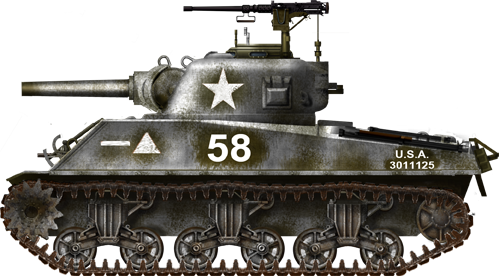
M4A3(105), Company H, 69th Tank Battalion, 6th Armored Division, Ardennes, December 1944.
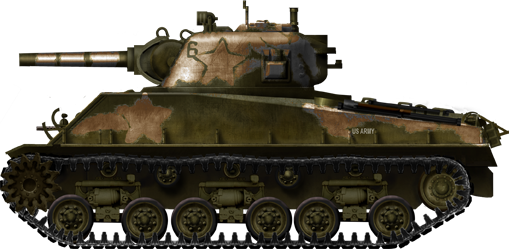
M4A3(105) Sherman, 713th Tank Battalion, Okinawa, 1945.
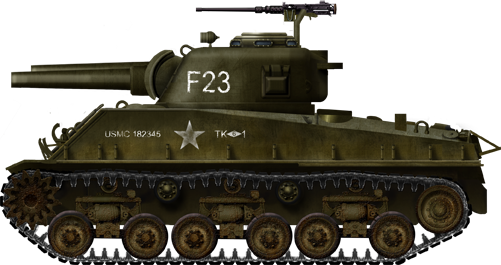
M4A3R2 “Zippo”, late version HVSS, flamethrower variant developed by the USMC, here deployed at Okinawa, in support to the 1st Marine Division, May 1945.
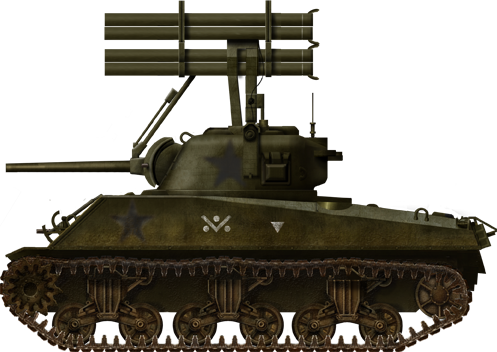
M4A3 Calliope from the 40th Tank Battalion, 14th Armored Division, Obermodern, Germany, March 1945

M4 Sherman Crab, Normandy, june 1944.
 US Derivated AFVs
US Derivated AFVs
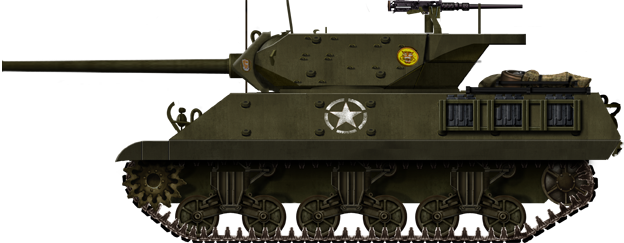
M10 Wolverine, the first US built tank destroyer, from the fall of 1942 to late 1944. 6700 were built, not including the British variant, the M10 Achilles.
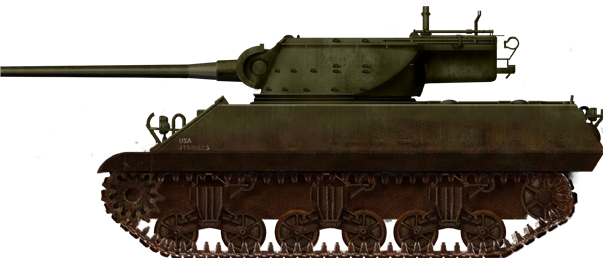
M36 Jackson (1944-1945), the late tank hunter, replacing the M10, armed with a 90 mm (3.54 in) M3. Around 1400 were built.
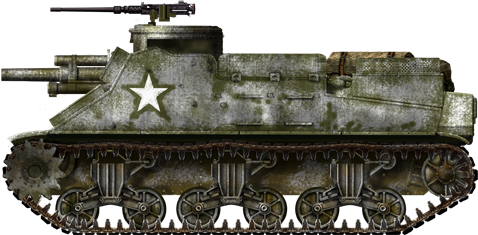
M7 Priest HMC. This was the main Allied SPG, which led to many conversions as artillery observation vehicles, tank hunters, personal carriers (“Defrocked Priest” and Kangaroo) and ammunition carriers. Over 4440 were built from 1942 to 1945, the first series being based on the M3 Lee. It quickly replaced the British Bishop and largely equipped Canadian, New Zealand, Australian, Free Polish and Free French forces.
 British Variants
British Variants
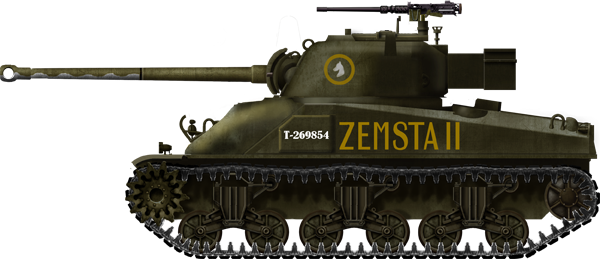
Sherman Firefly IC of a Polish armored division in Italy, 1944.
 Canadian derivatives
Canadian derivatives
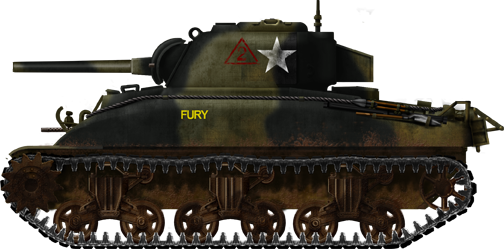
Grizzly I, a Canadian-built Sherman M4A1. Only 188 were built by MLW.
Gallery
Links & Resources about the M4 Sherman
The M4 Sherman (Main Wikipedia article)
The M4 on WWIIVehicles
The M4 Sherman on globalsecurity.org
Complementary data about the M4 on afvdb.50megs.com
Fine large scale M4 photos on the Shadock
A highly comprehensive list of Sherman books & reviews -modeler friendly
Sherman Minutia, tech database (the shadocks)
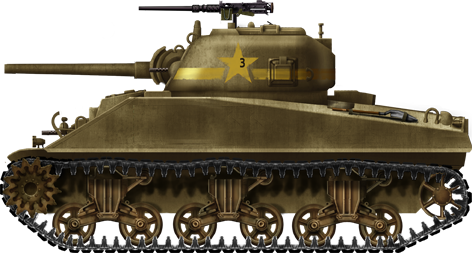
M4, early production version (1942), 13th Armored Regiment of the 1st Armored Division, Tunisia, March 1943. One of the rare Shermans actually painted sand beige in US Service.
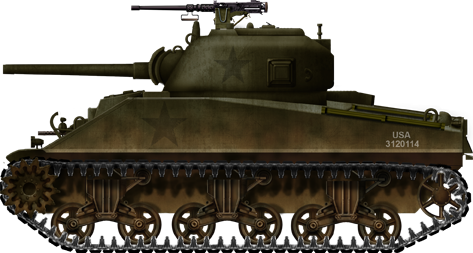
M4 Sherman, early production vehicle, 32nd Tank Battalion of the 3rd Armored Division, Normandy ,1944. Notice the “low visibility” stars.
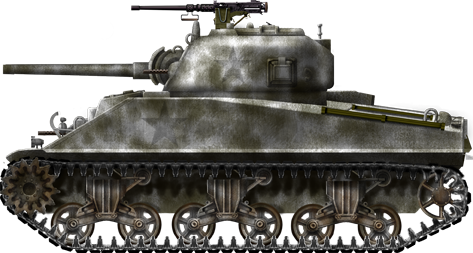
Early production M4 Sherman, 40th Tank Battalion, 8th Armored Division, Belgium, February 1945, at the end of the battle of the Bulge.
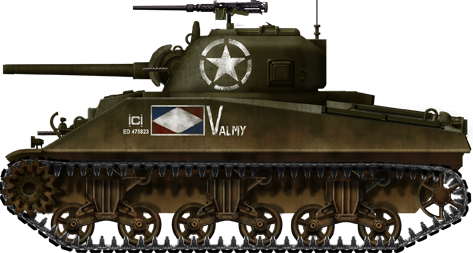
M4 Sherman, 2nd Armored Division, 1st Free French Army, Operation Anvil Dragoon, Provence, August 1944.
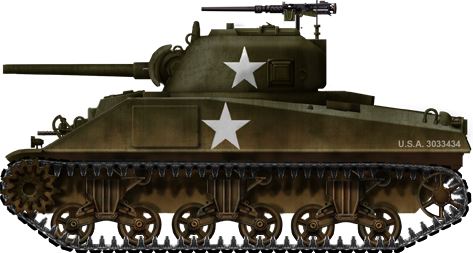
Early type M4, unknown unit, Normandy, summer 1944.
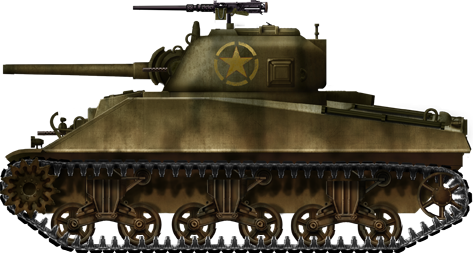
M4 Sherman, mid-production version (1943), of the 756th Tank Batallion, 5th Army, Monte Cassino sector, February 1944.
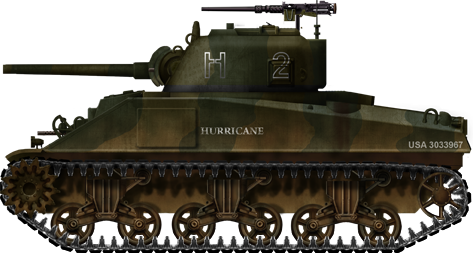
M4 Sherman “Hurricane”, H Company, 66th Armored Regiment, 2nd U.S. Armored Division, Normandy, June 1944.
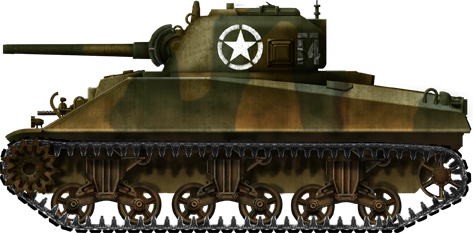
C company, 756th Tank Battalion, 5th Army, Italy, February 1944.
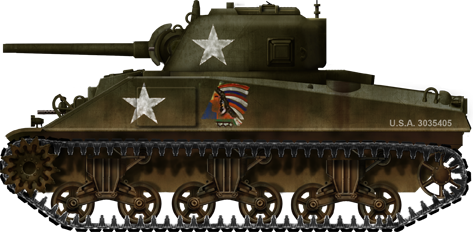
37th tank battalion, 4th U.S. Armored Division, Brittany, France, July 1944.
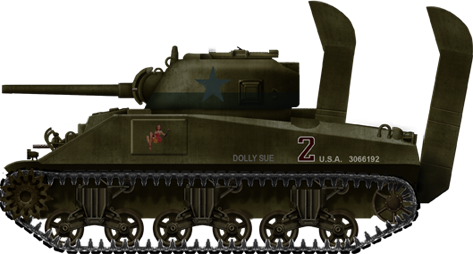
Sherman DWG (Deep Wading Gear), C company, 70th Tank Battalion, Utah Beach, Normandy on D-Day.
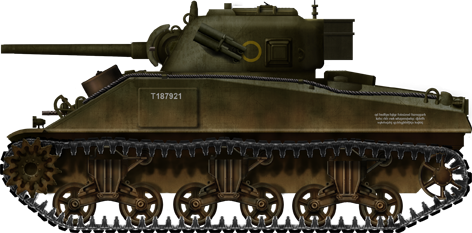
Sherman Mk.I of the 27th Staffordshire Yeomanry Armoured Brigade, C squadron, Second Regiment, Normandy, summer 44.
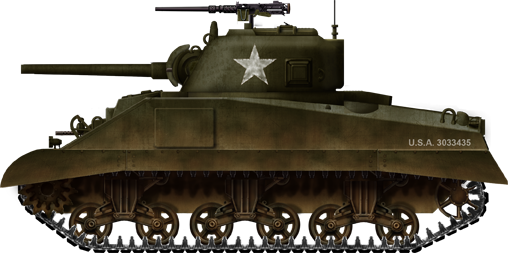
M4 with side skirts, unknown unit, Operation Cobra, Normandy, July 1944.
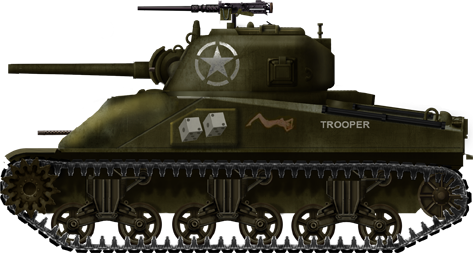
M4 with a composite hull, 175th Tank Battalion, 123rd Regiment, 33rd Infantry Division, Leyte, Philippines invasion, March 1945.
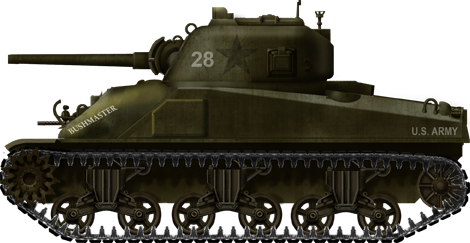
M4, composite hull, “Bushmaster” of the 763rd Tank Battalion, 96th Infantry Division, Leyte island, Philippines, fall 1945.
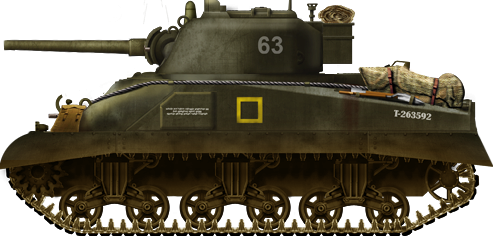
Sherman Mk.I Hybrid (composite hull) of the 144th RAC, Italy, March, 1944.
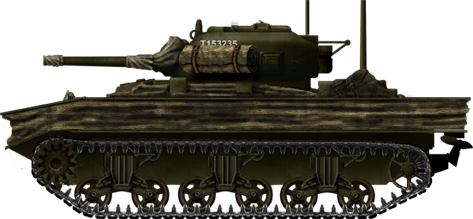
Sherman DD (Duplex Drive), 68th Tank Battalion, Omaha Beach, Normandy, D-Day.
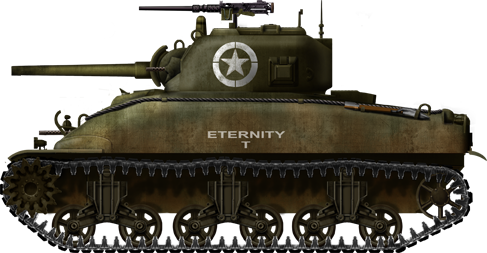
Sherman M4A1, early production variant, Operation Husky, Sicily, July 1943.
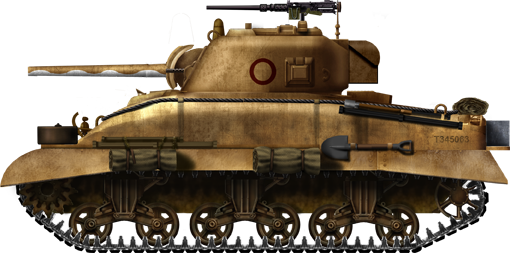
Sherman Mk.II, 3rd The King\’s Own Hussars, 5th Armored Brigade, VIIIth Army, Egypt, September 1942.
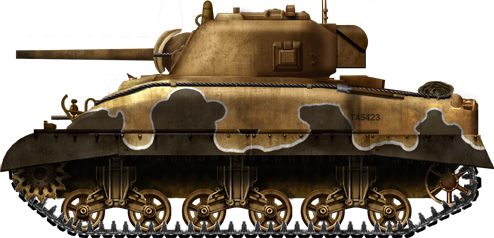
Sherman Mk.II early type, HQ, 3rd Armored Brigade, El Alamein, October 1942.
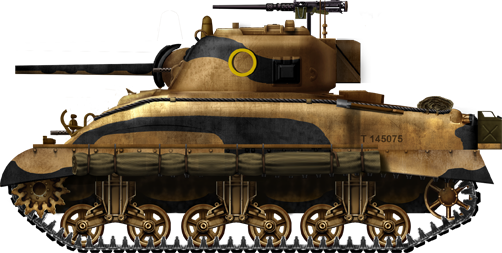
Sherman Mk.II, 9th Queen\’s Royal Lancers, 2nd Armored Brigade, 1st Division, Egypt, November 1942.
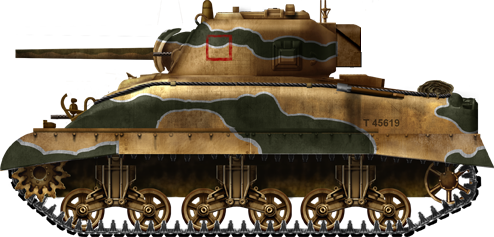
Sherman Mk.II early type from the 3rd Armored Brigade, El Alamein, October 1942.
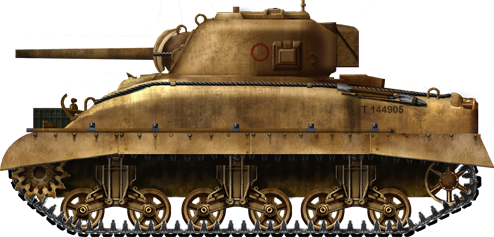
Sherman Mk.II (Direct Vision Type), C squadron, 3rd Hussards, 9th Armored Brigade, 2nd New Zealand Division, El Alamein, November 1942.
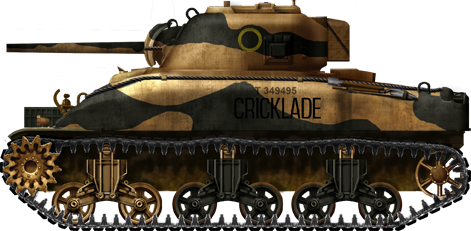
Sherman Mk.III late type, C Squadron, Royal Wilthshire Yeomanry, El Alamein, November 1942.
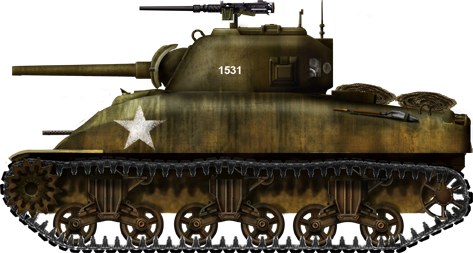
M4A1 mid-production vehicle, U.S. 1st Armored Division, “Henson Force”, Battle of El Guettar, Tunisia, March 1943.
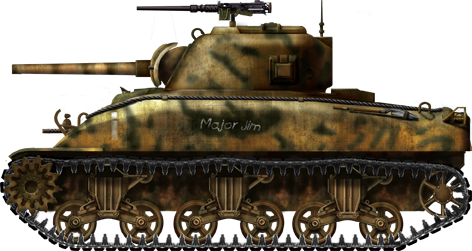
M4A1 mid-production, “Major Jim”, 2nd Battalion, 13th Armored Regiment, 1st Armored Division, Kasserine pass, February 1943.
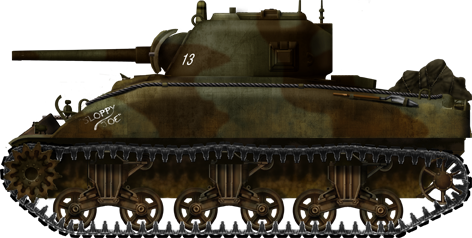
M4A1 mid-production, 603rd Armored Regiment of the 41st Infantry Division, Carolines Islands, Pacific, late 1944.
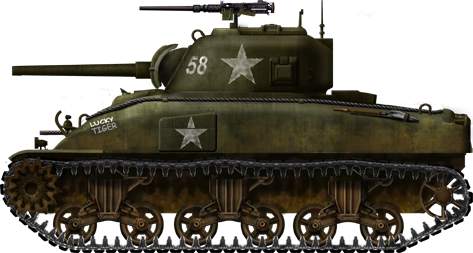
M4A1 late production, 7th Infantry Division, Ebeye Island, Pacific, part of the Kwajalein Atoll, Marshall Islands, January-February 1944.
W_11TB_10AD_Ardennes.png)
Sherman M4A1(76)W, 11th Tank Battalion of the 10th Armored Division, Ardennes, January 1945.
W_HVSS.png)
Sherman M4A1(76)W HVSS (Horizontal Volute Spring Suspension), Western Germany, March 1945.
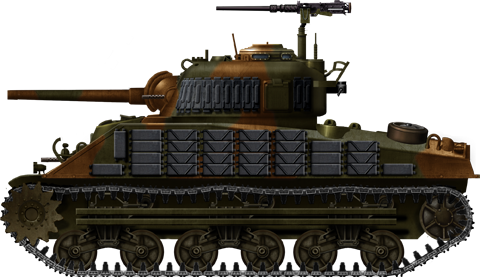
Sherman M4A2 (early type with a modified commander cupola and duckbills), Iwo Jima, February 1945.
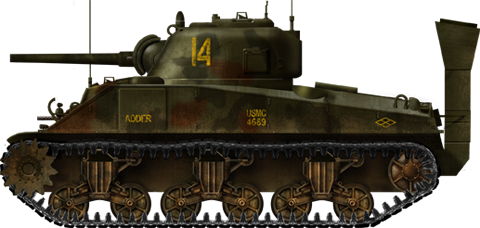
M4A2 (mid production) “Adder”, A company, 3rd USMC Tank Battalion, Iwo Jima, March 1945.
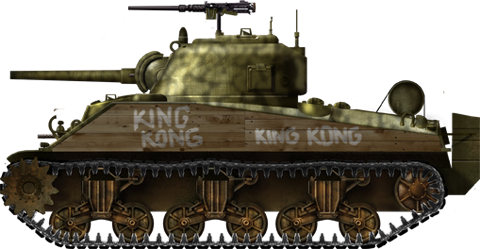
Sherman M4A2 “King Kong”, 4th Marine Tank Battalion, Saipan, 1944.
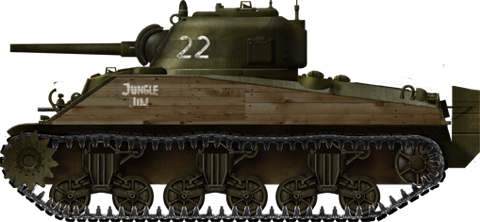
M4A2 mid-production, “Jungle Jim”, 4th Marine Tank Battalion, Saipan, 1944.
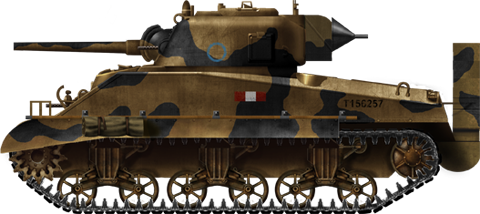
Sherman Mk.III, 3rd County of London Yeomanry (3rd CLY), Italy, Winter line sector, fall 1943.
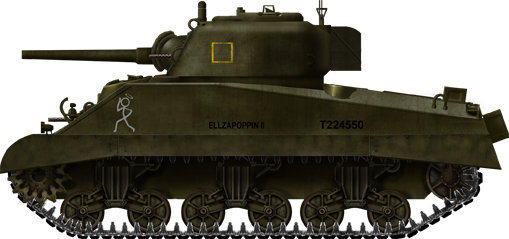
Sherman III “Ellza Poppin II”, 48th Royal Tank Regiment, Anzio, 1944.
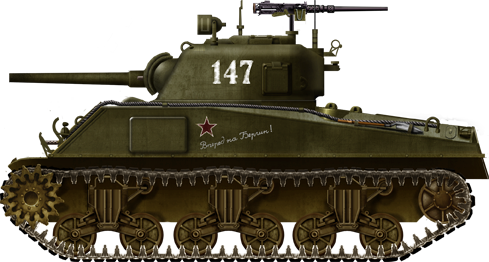
Russian M4A2 (late production), with the 47 degree slope and an added 108 mm (4.25 in) of frontal armor. Northern Front, fall 1943. Around 2000 M4s were delivered at Arkhangelsk. Most were M4A2, which were immediately put in use on the Northern Front. Those delivered through the “Persian Corridor” saw action in the Taman peninsula and in Northern Caucasus from early 1943.
W_russian.png)
Russian M4A2(75)W of the 46th Armored Brigade, 1st Armored Division, Northern Front, winter 1943-44.
.png)
Panzerkampfwagen M4-748(a), captured Sherman in German service, from an unidentified unit in Italy, 1944. Due to their appearance and the fact that few disabled Shermans were left in a repairable condition, perhaps less than twenty Shermans of all versions were ever used in German service, although clear evidence shows this occured in Tunisia, Italy and during the Battle of the Bulge.
W_Russian_1.png)
M4A2(76)W, early type, in Russian service with duckbills, Northern Front, Eastern Prussia, late 1944. Slogan: “To Berlin!”.
W_late_Russian.png)
M4A2(76)W, late type with duckbills in Russian service, Battle of Berlin, May 1945.
W_HVSS_Germany45.png)
Sherman M4A2(76)W HVSS of Patton\’s U.S. 2nd Armored Division, Western Germany, March 1945.
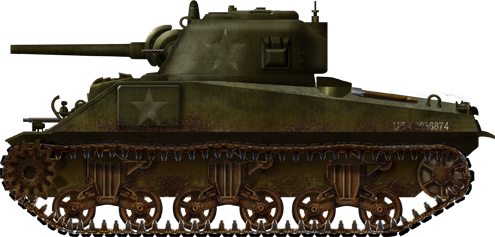
M4A3 early type, 3rd Armored Division, Normandy, June 1944.
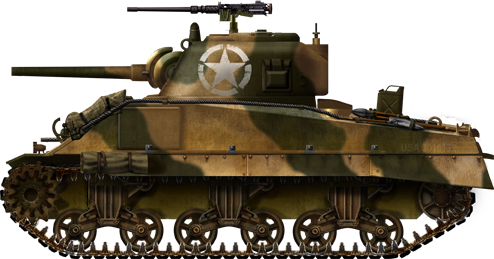
Sherman M4A3 early type, 1st Armored Division, liberation of Rome, June 1944.
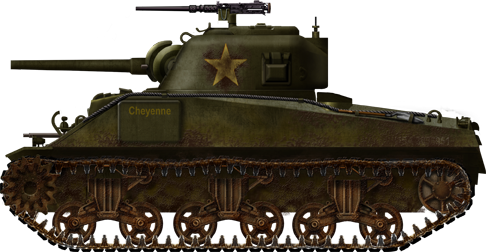
Sherman M4A3 mid-production “Cheyenne”, 2nd Armored Divison, Normandy, June 1944.
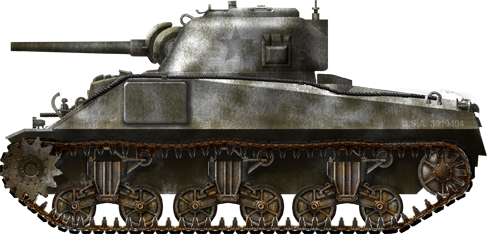
M4A3 mid-production vehicle with late train type, 11th Armored Division, in support of the 30th U.S. Infantry Division, Ardennes, Belgium, January 1945.
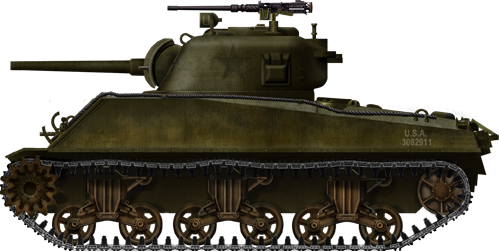
Sherman M4A3(75)W (equipped with duckbills and metal track links) of the 4th Armored Division, 3rd US Army, battle of Nancy, September 1944.
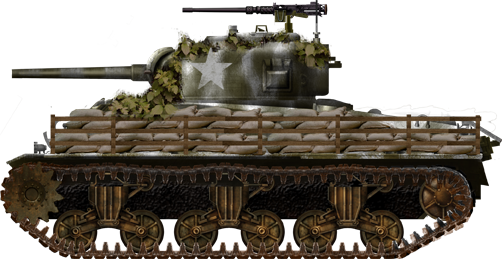
An up-armored M4A3 in the Ardennes, January 1945. Because of the lack of protection offered by the early versions, experienced crews took the matter into their own hands and usually applied improvised protective measures in the field. Wooden planks, beams, rails, steel plates, spare track links and improvised cofferdams made of wood and sandbags, like seen here, were some of the solutions found. The engine could not keep up with the extra load, and, after an inquiry following an unusual rate of breakdowns and high consumption figures, Patton forbade tank crews from such practices.
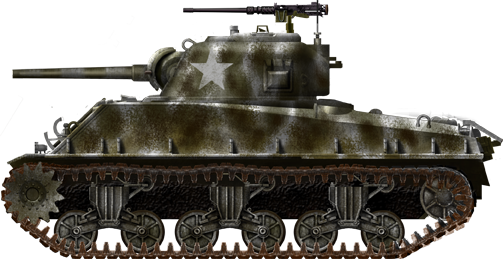
M4A3 late production vehicle with an improvised camouflage made of regular washable white paint and mud spots, South-Western Germany, March 1945.
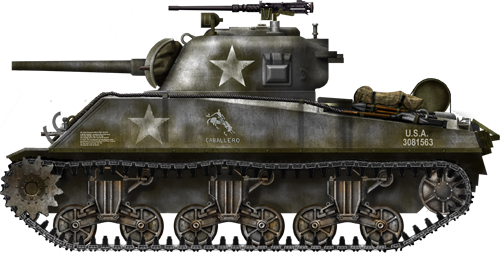
M4A3(75)W of the 6th Armored Division, Ardennes, Belgium, January 1945.
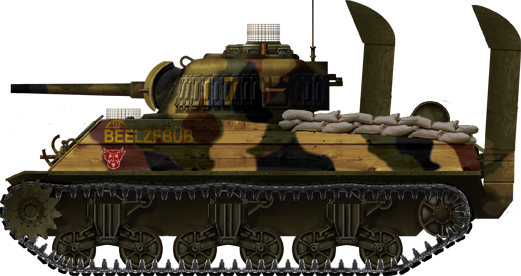
M4A3(75)W “Beelzebub” of B company, 4th USMC Battalion at Iwo Jima, January 1945. Notice the rare camouflage, wooden panels, Deep Wading Gear and protective grids above the hatches.
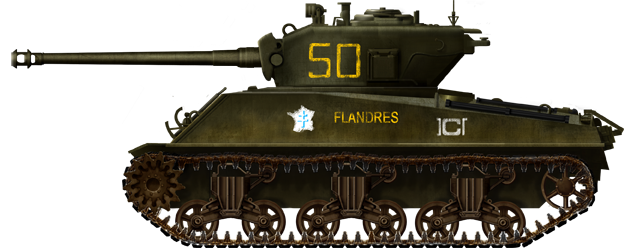
M4A3(76)W from the 12th African Light Infantry Regiment (1st French Army), Vosges area, fall 1944.
w.png)
M4A3(76)W HVSS of the 41st Tank Battalion, 11th Armored Division, 3rd US Army, Rhine western banks, February 1945
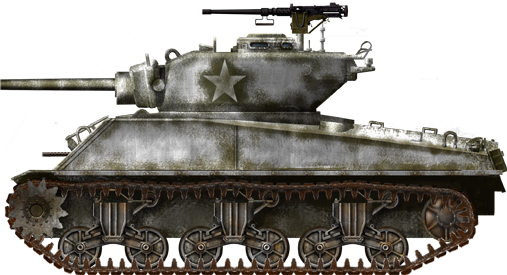
M4A3E2 “Jumbo” from the 33rd Battalion, 3rd US Armored Division, Houffalize, Belgium, January 1945.
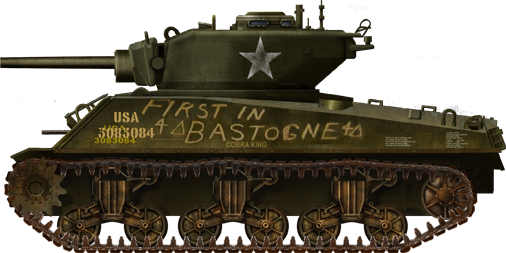
M4A3E2 Jumbo “Cobra King” with the “First in Bastogne” inscription, probably the most famous Jumbo of the entire 4th Armored Division.
w_Sherman_Jumbo.png)
M4A3E2(76)W “Jumbo” from the 37th Tank Battalion, 4th Armored Division, Alez, Germany, March 1945.
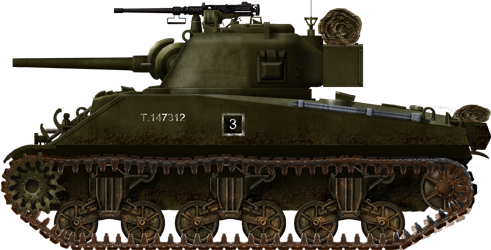
Sherman V (M4A4) of the 2nd Armored Brigade, Irish Guards, Operation Goodwood, June 1944.
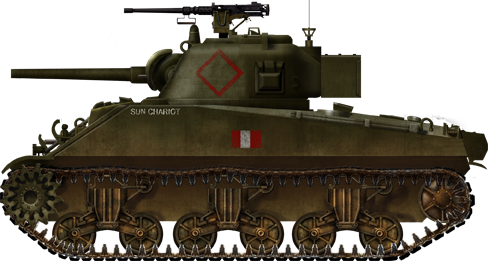
Sherman V of another unidentified Irish unit, Operation Goodwood, Normandy, June 1944.
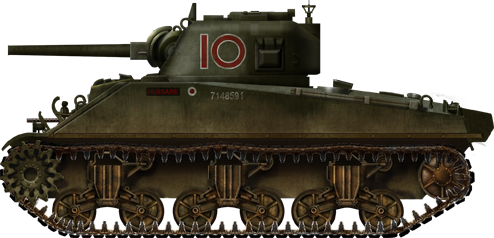
M4A4 (Sherman V) of the RHQ 13/18th Royal Hussars, Normandy, June 1944.
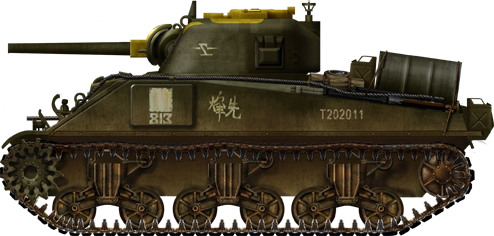
Chinese M4A4 from the 1st Provisional Tank Group, Burma, 1945.
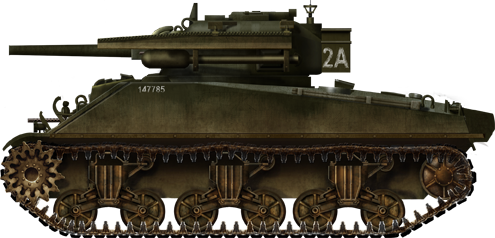
Rocket launcher version Sherman V “Tulip” from the 1st Coldstream Guards, Rhine offensive, early 1945.
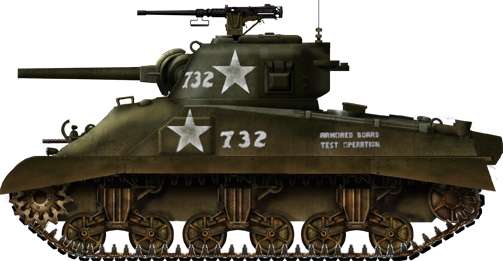
M4A6 from the USMC in trials in early 1944. Built by Detroit Arsenal with a diesel Caterpillar D200A radial. Only saw service in the Pacific Theater.
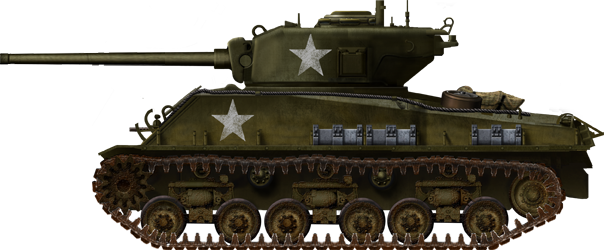
M4A3E8 “Easy Eight”, the last evolution of the Sherman, Southern Germany, May 1945.
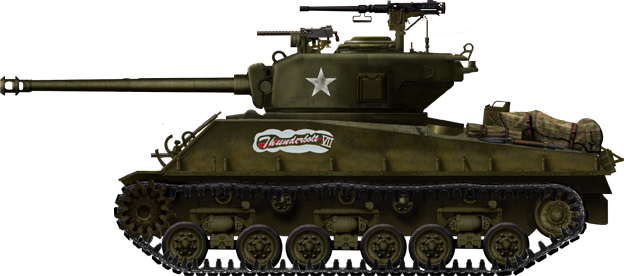
Colonel Creighton Abrams\’ “Thunderbolt VII” and his famous personal insignia, Horazdovice, May 1945.
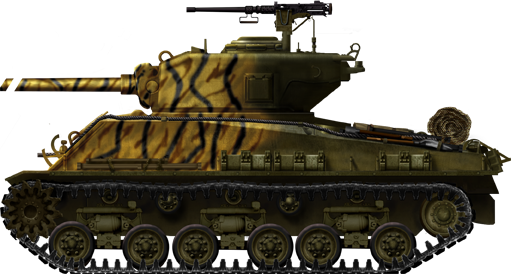
South Korean Easy Eight in 1952 with the famous “Tiger Pattern”.

WW2 Tanks




























WW2 tanks posters

All Tiger tanks liveries.

Panther liveries and variants

WW2 Armour - All tanks











Tanks aces and single tanks series

Find more there

Museums, Movies, Books & Games
The Tanks and Armor in pop culture
Tanks and armored vehicles in general are only really grasped when seen first person: The mass, the scale, it's all there. Explore also the way tanks were covered in the movie industry, in books and in video games.Movies:
Best tanks movie on warhistoryonline.com
On imdb.com
On bestsimilar.com/
miltours.com
liveabout.com/
watchmojo.com
Video Games:
pcgamesn.com
historyhit.com
levvvel.com
vg247.com/best-tank-games
mmobomb.com/
alienwarearena.com


